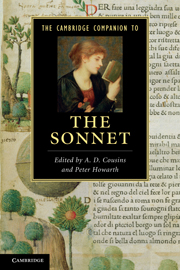Book contents
- Frontmatter
- Introduction
- 1 Contemporary poets and the sonnet
- 2 The sonnet and the lyric mode
- 3 The sonnet, subjectivity and gender
- 4 The English sonnet in manuscript, print and mass media
- 5 European beginnings and transmissions
- 6 Desire, discontent, parody
- 7 Shakespeare’s Sonnets
- 8 Sacred desire, forms of belief
- 9 Survival and change: the sonnet from Milton to the Romantics
- 10 The Romantic sonnet
- 11 The Victorian sonnet
- 12 The modern sonnet
- 13 The contemporary sonnet
- Further reading
- Index
7 - Shakespeare’s Sonnets
Published online by Cambridge University Press: 28 May 2011
- Frontmatter
- Introduction
- 1 Contemporary poets and the sonnet
- 2 The sonnet and the lyric mode
- 3 The sonnet, subjectivity and gender
- 4 The English sonnet in manuscript, print and mass media
- 5 European beginnings and transmissions
- 6 Desire, discontent, parody
- 7 Shakespeare’s Sonnets
- 8 Sacred desire, forms of belief
- 9 Survival and change: the sonnet from Milton to the Romantics
- 10 The Romantic sonnet
- 11 The Victorian sonnet
- 12 The modern sonnet
- 13 The contemporary sonnet
- Further reading
- Index
Summary
Shakespeare’s Sonnets, the most famous sonnets in the English language, are surrounded by uncertainties. Almost all of them were probably written in the 1590s, at the height of the Elizabethan fashion for writing sonnets; but they were published in 1609 well after the fashion had passed, and we do not know whether Shakespeare authorized their appearance in print. Consequently we don’t know whether the order of the poems is that intended by Shakespeare. In the order as we have it, Sonnets 1–126 are closely concerned with a young man; from Sonnet 127 until 152, the so-called Dark Lady becomes a focus of attention. The sonnets ending the collection, 153 and 154, are playfully mythological poems associating love with disease and portraying desire as unquenchable. Yet many of the sonnets do not identify the gender of the person they address or discuss, so if we don’t know whether the published order of the Sonnets is actually Shakespeare’s, we cannot always be sure which sonnets refer to the young man and which to the Dark Lady. Other things are also unclear, among them being the following. Was the young man a real person – and, if so, who? Was the Dark Lady real? If so, who was she? And who was the Mr W. H. to whom the publisher of the collection dedicated it?
- Type
- Chapter
- Information
- The Cambridge Companion to the Sonnet , pp. 125 - 144Publisher: Cambridge University PressPrint publication year: 2011



